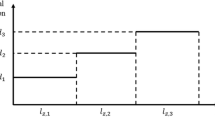Abstract
The availability of refueling stations for alternative fuels is of high importance for the penetration of alternative fuel vehicles (AFV) in today’s markets and is an important lever for sustainable mobility. Therefore, refueling station network deployment strategies are currently of great interest to researchers. Several quantitative location models have been specifically developed, adapted, and applied to determine optimal refueling station locations and network build-up strategies for AFV refueling from an overall system’s perspective. However, the network operator’s intrinsic economic objectives and its preference for transforming the existing refueling station network rather than building up new refueling stations are subordinate in most research. That is why a new formulation of a flow-based location model is introduced in this study that not only decides on the locations of new alternative refueling stations but also on the provisioned capacities of multiple fuel types at each newly opened and each already existing refueling station in a multi-period planning horizon. This new approach uses a profit-oriented, cash flow-based objective function to transform the existing refueling station network over time. A case study depicting German highways is presented to validate the new model and the computational results are discussed.
Access this chapter
Tax calculation will be finalised at checkout
Purchases are for personal use only
Similar content being viewed by others
References
Rose, P. K., Nugroho, R., Gnann, T., et al. (2020). Optimal development of alternative fuel station networks considering node capacity restrictions. Transportation Research Part D: Transport and Environment, 78, 1–16. https://doi.org/10.1016/j.trd.2019.11.018
Zhang, A., Kang, J. E., & Kwon, C. (2017). Incorporating demand dynamics in multi-period capacitated fast-charging location planning for electric vehicles. Transportation Research Part B: Methodological, 103, 5–29. https://doi.org/10.1016/j.trb.2017.04.016
Böhle, A. (2021). Multi-period optimization of the refuelling infrastructure for alternative fuel vehicles. Junior Management Science, 6, 790–825. https://doi.org/10.5282/JUMS/V6I4PP673-699
Rose, P. K., & Neumann, F. (2020). Hydrogen refueling station networks for heavy-duty vehicles in future power systems. Transportation Research Part D: Transport and Environment, 83, 1–17. https://doi.org/10.1016/j.trd.2020.102358
Kuby, M., & Lim, S. (2005). The flow-refueling location problem for alternative-fuel vehicles. Socio-Economic Planning Sciences, 39, 125–145. https://doi.org/10.1016/j.seps.2004.03.001
Capar, I., Kuby, M., Leon, V. J. Tsai, Y.-J. (2013). An arc cover–path-cover formulation and strategic analysis of alternative-fuel station locations. European Journal of Operational Research, 227, 142–151. https://doi.org/10.1016/j.ejor.2012.11.033
Tafakkori, K., Bozorgi-Amiri, A., & Yousefi-Babadi, A. (2020). Sustainable generalized refueling station location problem under uncertainty. Sustainable Cities and Society, 63, 1–14. https://doi.org/10.1016/j.scs.2020.102497
Wang, Y.-W., & Lin, C.-C. (2013). Locating multiple types of recharging stations for battery-powered electric vehicle transport. Transportation Research Part E: Logistics and Transportation Review, 58, 76–87. https://doi.org/10.1016/j.tre.2013.07.003
Bersani, C., Minciardi, R., Sacile, R., Trasforini, E. (2009). Network planning of fuelling service stations in a near-term competitive scenario of the hydrogen economy. Socio-Economic Planning Sciences, 43, 55–71. https://doi.org/10.1016/j.seps.2008.02.001
Crönert, T., & Minner, S. (2021). Location selection for hydrogen fuel stations under emerging provider competition. Transportation Research Part C: Emerging Technologies, 133, 1–17. https://doi.org/10.1016/j.trc.2021.103426
H2 Mobility. (2022). Overview—Hydrogen refuelling for heavy duty vehicles. https://h2-mobility.de/wp-content/uploads/2022/03/H2M_Overview_HDV_Refuelling_2022.pdf. Last accessed 2022/07/07
Acknowledgements
This work was part of the research project THEWA, which was funded by the Ministry of Science and Culture of Lower Saxony (Germany). The authors are responsible for the contents of this publication.
Author information
Authors and Affiliations
Corresponding author
Editor information
Editors and Affiliations
Rights and permissions
Copyright information
© 2023 The Author(s), under exclusive license to Springer Nature Switzerland AG
About this paper
Cite this paper
Bätge, T., Weckenborg, C., Spengler, T.S. (2023). A New Flow-Based Location and Capacity Model for Profit-Oriented Refueling Station Network Transformation. In: Grothe, O., Nickel, S., Rebennack, S., Stein, O. (eds) Operations Research Proceedings 2022. OR 2022. Lecture Notes in Operations Research. Springer, Cham. https://doi.org/10.1007/978-3-031-24907-5_58
Download citation
DOI: https://doi.org/10.1007/978-3-031-24907-5_58
Published:
Publisher Name: Springer, Cham
Print ISBN: 978-3-031-24906-8
Online ISBN: 978-3-031-24907-5
eBook Packages: Business and ManagementBusiness and Management (R0)




